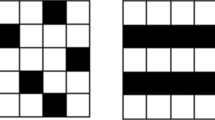Abstract
The video error concealment with data hiding (VECDH) method aims to conceal video errors due to transmission according to the auxiliary data directly extracted from the received video file. It has the property that can well reduce the error propagated between spatially/temporally correlated macro-blocks. It is required that, the embedded information at the sender side should well capture/reflect the video characteristics. Moreover, the retrieved data should be capable of correcting video errors. The existing VECDH algorithms often embed the required information into the corresponding video frames to gain the transparency. However, at the receiver side, the reconstruction process may loss important information, which could result in a seriously distorted video. To improve the concealment performance, we propose an efficient VECDH algorithm based on compressed sensing (CS) in this paper. For the proposed method, the frame features to be embedded in every video frame are generated from the frame residuals CS measurements and scrambled with other frame features as marked data. The marked data is embedded into the corresponding frames by modulating color-triples for its least impacts on the carriers. For the receiver, the extracted data is used to reconstruct residuals to conceal errors. Error positions are located using the set theory. Since the CS has the ability to sample a signal within a lower sampling rate than the Shannon–Nyquist rate, the original signal could be reconstructed very well in theory. This indicates that the proposed method could benefit from the CS, and therefore keep better error concealment behavior. The experimental results show that the PSNR values gain about 10 dB averagely and the proposed scheme in this paper improves the video quality significantly comparing with the exiting VECDH schemes.
























Similar content being viewed by others
References
Lie, W.-N., Lee, C.-M., Yeh, C.-H., & Gao, X.-W. (2014). Motion vector recovery for video error concealment by using iterative dynamic-programming optimization. IEEE Transactions on Multimedia, 16(1), 216–227.
Xu, Y.-L., & Zhou, Y.-H. (2008). Adaptive temporal error concealment scheme for H.264/AVC video decoder. IEEE Transactions on Consumer Electronics, 54(4), 1846–1851.
Liu, J., Zhai, G., Yang, X., Yang, B., & Chen, L. (2015). Spatial error concealment with an adaptive linear predicto. IEEE Transactions on Circuits and Systems of Video Technology, 25(3), 353–366.
Adsumilli, C. B., Farias, M. C. Q., Mitra, S. K., & Carli, M. (2005). A robust error concealment technique using data hiding for image and video transmission over lossy channels. IEEE Transactions on Circuits and System for Video Technology, 15(11), 1394–1406.
Yao, Y., Zhang, W., & Yu, N. (2012). Adaptive video error concealment using reversible data hiding. In Proceeding of international conference on multimedia information networking and security (MINES) (pp. 658–661).
Akbari, A., Danyali, H., & Rashidpour, M. (2012). Error concealment using data hiding for resolution scalable transmission. In Proceeding of the 16th CSI international symposium on artificial intelligence and signal processing (AISP) (pp. 228–232).
Liu, Y., & Li, Y. (2000). Error concealment for digital images using data hiding. In Proceeding of the 9th digital signal processing workshop hunt (pp. 1–6).
Bartolini, F., Manetti, A., Piva, A., & Barni, M. (2001). A data hiding approach for correcting errors in H.263 video transmitted over a noisy channel. In Proceeding of IEEE workshop on multimedia signal processing (pp. 65–70).
Mun, S., & Fowler, J. E. (2011). Residual reconstruction for block-based compressed sensing of video. In Data compression conference (DCC) (pp. 183–192).
Davenport, M. A., et al. (2010). Signal processing with compressive measurements. IEEE Journal of Selected Topics in Signal Processing, 4(2), 445–460.
Yang, J., Yuan, X., Liao, X., Llull, P., Brady, D. J., Sapiro, G., et al. (2014). Video compressive sensing using gaussian mixture models. IEEE Transactions on Image Processing, 23(11), 4863–4878.
Li, S., & Qi, H. (2015). A Douglas–Rachford splitting approach to compressed sensing image recovery using low-rank regularization. IEEE Transactions on Image Processing, 24(11), 4240–4249.
Qian, Q., Wang, H., Hu, Y., et al. (2016). A dual fragile watermarking scheme for speech authentication. Multimedia Tools and Applications, 75(21), 13431–13450.
Wu, H.-Z., Shi, Y.-Q., Wang, H.-X., & Zhou, L.-N. (2017). Separable reversible data hiding for encrypted palette images with color partitioning and flipping verification. IEEE Transactions on Circuits and Systems for Video Technology, 27(8), 1620–1631.
Wang, J., Kwon, S., Li, P., & Shim, B. (2016). Recovery of sparse signals via generalized orthogonal matching pursuit: A new analysis. IEEE Transactions on Signal Processing, 64(4), 1076–1089.
Pan, Z., Lei, J., Zhang, Y., Sun, X., & Kwong, S. (2016). Fast motion estimation based on content property for low-complexity H.265/HEVC encoder. IEEE Transactions on Broadcasting, 62(3), 675–684.
Pan, Z., Zhang, Y., & Kwong, S. (2015). Efficient motion and disparity estimation optimization for low complexity multiview video coding. IEEE Transactions on Broadcasting, 61(2), 166–176.
Davenport, M. A., Boufounos, P. T., Wakin, M. B., & Baraniuk, R. G. (2010). Signal processing with compressive measurements. IEEE Journal of Selected Topics in Signal Processing, 4(2), 445–460.
Zhao, H., & Ren, J. (2016). Cognitive computation of compressed sensing for watermark signal measurement. Cognitive Computation, 8(2), 246–260.
Peng, Q., Deng, Y., Yang, T.-W., & Zhu, C.-J. (2006). A novel general end-to-end distortion estimation model for video transmission. Journal of Image and Graphics, 11(6), 792–797.
Gu, B., Sun, X., & Sheng, V. S. (2017). Structural minimax probability machine. IEEE Transactions on Neural Networks and Learning Systems, 28(7), 1646–1656.
Acknowledgements
This work is supported by the National Natural Science Foundation of China (NSFC) under the Grant No. U1536110. The Priority Academic Program Development of Jiangsu Higer Education Institutions, Jiangsu Collaborative Innovation Center on Atmospheric Environment and Equipment Technology, and Tibet Autonomous Region Soft Science Research program under the Grant No. Z2016R67F02.
Author information
Authors and Affiliations
Corresponding author
Rights and permissions
About this article
Cite this article
Chen, Y., Wang, H., Wu, H. et al. A video error concealment method using data hiding based on compressed sensing over lossy channel. Telecommun Syst 68, 337–349 (2018). https://doi.org/10.1007/s11235-017-0393-1
Published:
Issue Date:
DOI: https://doi.org/10.1007/s11235-017-0393-1




